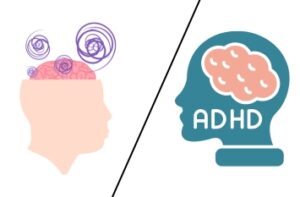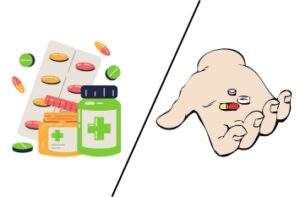
ADHD and Sensory Processing: What’s the Connection?
ADHD and Sensory Processing: What’s the Connection? When most people think of ADHD (Attention Deficit Hyperactivity Disorder), they think of distractibility, impulsivity, or difficulty sitting

Schizoaffective disorder and schizotypal personality disorder are both complex mental health conditions that can significantly impact individuals’ lives. While they share similarities with schizophrenia in terms of symptoms and diagnostic criteria, they each present distinct challenges and characteristics. Schizoaffective disorder is relatively rare, affecting about 0.3% of the population.
Research suggests no significant difference in prevalence between males and females for schizoaffective disorder, with both genders affected at similar rates. On the other hand, schizotypal personality disorder, although also rare, is a separate condition characterized by eccentric behavior, peculiar thought patterns, and social anxiety.
It typically emerges in early adulthood and affects men slightly more frequently than women. Understanding the distinctions between these disorders is crucial for accurate diagnosis and effective treatment planning.
Schizoaffective disorder is a psychiatric condition that blends elements of schizophrenia and mood disorders, such as bipolar disorder or major depression. Unlike schizophrenia, which primarily involves hallucinations, delusions, and disorganized thinking, schizoaffective disorder combines these symptoms with prominent mood disturbances.
This complex interplay can result in periods of intense psychosis alongside episodes of depression or mania. Diagnosing schizoaffective disorder requires careful evaluation by mental health professionals to differentiate it from other related disorders.
Understanding the nature of schizoaffective disorder is essential for providing appropriate support and intervention for those affected by this challenging condition.
The exact causes of schizoaffective disorder are not fully understood, but research suggests a combination of genetic, biological, and environmental factors may contribute:
Intelligence and cognitive abilities vary widely among individuals with schizoaffective disorder, just as they do in the general population. There is no inherent correlation between schizoaffective disorder and intelligence levels.
Some individuals with this condition may exhibit high levels of intelligence, while others may experience cognitive challenges. Factors such as the severity of symptoms, medication side effects, and individual differences in brain function can all influence cognitive functioning in people with schizoaffective disorder.
It’s important to recognize that intelligence is a complex trait influenced by multiple factors beyond the presence of a mental health condition. With appropriate support, including therapy to enhance coping skills and medication to manage symptoms, many individuals with schizoaffective disorder can lead fulfilling and productive lives, utilizing their strengths and abilities to navigate their challenges effectively.
Schizotypal personality disorder (STPD) is a psychiatric condition characterized by unusual beliefs, behaviors, and difficulty forming close relationships. Individuals with STPD often exhibit eccentricities in thinking, appearance, and communication.
They may have peculiar beliefs or magical thinking, such as superstitious ideas or beliefs in extrasensory perception. Social anxiety and discomfort in social situations are common, leading to isolation or a preference for solitary activities. While they may experience brief psychotic episodes under stress, these are not as severe or frequent as in schizophrenia.
Diagnosis of schizotypal personality disorder requires careful evaluation by mental health professionals to differentiate it from other personality disorders and psychotic disorders.
The exact causes of schizotypal personality disorder are not fully understood, but it is believed to be influenced by a combination of genetic, environmental, and neurobiological factors. Some potential causes and risk factors include:
Individuals with schizotypal personality disorder may exhibit behaviors that include talking to themselves or appearing to have conversations with imaginary individuals.
This symptom, often referred to as “ideas of reference,” can manifest as a belief that external events or occurrences have a particular and unusual significance to the individual. However, it’s important to note that not everyone with schizotypal personality disorder will engage in this behavior, and its presence can vary in intensity among affected individuals.
These behaviors are part of a broader pattern of eccentricities and social discomfort characteristic of schizotypal personality disorder, which typically emerges in early adulthood and can impact various aspects of daily functioning and interpersonal relationships.
Schizoaffective disorder and schizotypal personality disorder share some similarities but are distinct clinical entities. Both conditions can involve difficulties in social interactions and unusual thinking patterns.
However, schizoaffective disorder is primarily characterized by a combination of psychotic symptoms (hallucinations, delusions) and mood symptoms (depression, mania), whereas schizotypal personality disorder is characterized by eccentric behavior, peculiar thought patterns, and social anxiety.
Feature | Schizoaffective Disorder | Schizotypal Personality Disorder |
Psychotic Symptoms | Hallucinations, delusions | Ideas of reference, magical thinking |
Mood Symptoms | Depression, mania, mixed episodes | Typically lacks mood episodes |
Social Interactions | Impaired due to psychotic and mood symptoms | Impaired due to social anxiety and eccentric behavior |
Onset | Often in early adulthood | Often in early adulthood |
Treatment | Medication (antipsychotics, mood stabilizers), therapy | Therapy (cognitive behavioral therapy), social skills training |
Prognosis | Can vary; some individuals may have recurrent episodes | Chronic but symptoms may improve with treatment |
Understanding these distinctions can aid in accurate diagnosis and appropriate treatment planning for individuals affected by either schizoaffective disorder or schizotypal personality disorder.
Distinguishing between schizoaffective disorder and schizotypal personality disorder is essential for clinicians and individuals alike. While both conditions involve disturbances in thinking and perception, schizoaffective disorder combines psychotic symptoms with mood disturbances, requiring a nuanced approach to treatment. In contrast, schizotypal personality disorder is characterized by eccentric behavior and social discomfort without the mood episodes seen in schizoaffective disorder.
Recognizing these differences allows for tailored interventions that can significantly improve the quality of life for those affected by these complex psychiatric conditions.

ADHD and Sensory Processing: What’s the Connection? When most people think of ADHD (Attention Deficit Hyperactivity Disorder), they think of distractibility, impulsivity, or difficulty sitting

Spravato vs Ketamine Infusions. What’s the Difference If you’ve been exploring treatment options for depression that hasn’t responded to medication, you may have come across

How Long Does It Take for Psychiatric Medication to Work? When you start taking psychiatric medication — whether for depression, anxiety, bipolar disorder, or another
